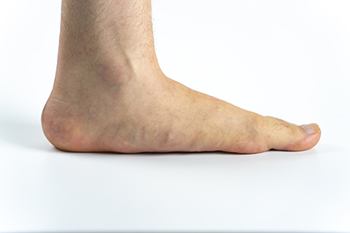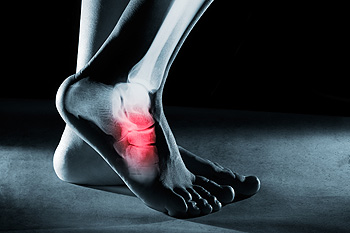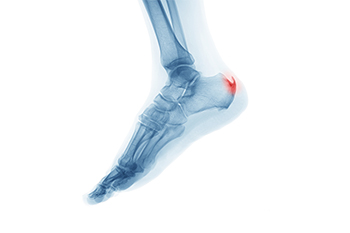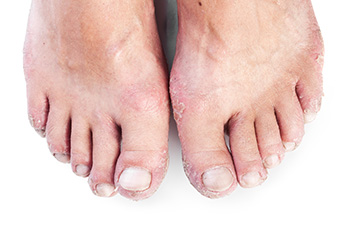Blog - Foot Doctor, Chambersburg and McConnellsburg, PA
Ways for Seniors to Avoid Falling

Statistics show that at least one-third of people 65 and older fall at least once a year, and many fall multiple times. Here are a few ways to avoid falling at home, which can bring broken bones and hospitalization. Because most falls by seniors occur in the bathroom, here are some suggestions to prevent injury. Make sure the bathroom is well-lit, including night lights, install a shower chair or bench to sit on when bathing, and have non-skid rubberized mats installed on the floor. Having handrails installed in the tub or shower and near the toilet, and ample lighting near the bed and on the way to the bathroom is beneficial. If walking is difficult, especially at night, you may wish to use a bedside commode. Falls may also be caused by other factors, such as medications that cause dizziness, eyeglasses with an outdated prescription, and neuropathy or other underlying illness that make walking difficult. If you have fallen or need more information about preventing a fall, it is suggested that you contact a podiatrist.
Preventing falls among the elderly is very important. If you are older and have fallen or fear that you are prone to falling, consult with Dr. Steven Schwartz from Pennsylvania. Our doctor will assess your condition and provide you with quality advice and care.
Every 11 seconds, an elderly American is being treated in an emergency room for a fall related injury. Falls are the leading cause of head and hip injuries for those 65 and older. Due to decreases in strength, balance, senses, and lack of awareness, elderly persons are very susceptible to falling. Thankfully, there are a number of things older persons can do to prevent falls.
How to Prevent Falls
Some effective methods that older persons can do to prevent falls include:
- Enrolling in strength and balance exercise program to increase balance and strength
- Periodically having your sight and hearing checked
- Discuss any medications you have with a doctor to see if it increases the risk of falling
- Clearing the house of falling hazards and installing devices like grab bars and railings
- Utilizing a walker or cane
- Wearing shoes that provide good support and cushioning
- Talking to family members about falling and increasing awareness
Falling can be a traumatic and embarrassing experience for elderly persons; this can make them less willing to leave the house, and less willing to talk to someone about their fears of falling. Doing such things, however, will increase the likelihood of tripping or losing one’s balance. Knowing the causes of falling and how to prevent them is the best way to mitigate the risk of serious injury.
If you have any questions, please feel free to contact our offices located in Chambersburg, and Mcconnellsburg, PA . We offer the newest diagnostic and treatment technologies for all your foot care needs.
Overpronation From Flat Feet

Overpronation is when the arch of the foot collapses and the foot and ankle roll inward when walking. Medically, this is called pes planus, flexible flatfoot, or more commonly, flat feet. Those who overpronate can be at risk for more injuries than others. Children are born with flat feet, but arches typically develop in the teenage years. Overpronation can occur when the arches are overly flexible, and it can be caused by obesity or pregnancy, inflammation or damage to the tendon, or arthritis in the foot, among other things. Walking or standing can be uncomfortable for those who overpronate. Relief can be found by wearing more supportive shoes, using orthotics, and maintaining a normal body weight. If you have ongoing foot pain, it is suggested that you make an appointment with a podiatrist for a proper diagnosis and treatment plan.
Flatfoot is a condition many people suffer from. If you have flat feet, contact Dr. Steven Schwartz from Pennsylvania. Our doctor will treat your foot and ankle needs.
What Are Flat Feet?
Flatfoot is a condition in which the arch of the foot is depressed and the sole of the foot is almost completely in contact with the ground. About 20-30% of the population generally has flat feet because their arches never formed during growth.
Conditions & Problems:
Having flat feet makes it difficult to run or walk because of the stress placed on the ankles.
Alignment – The general alignment of your legs can be disrupted, because the ankles move inward which can cause major discomfort.
Knees – If you have complications with your knees, flat feet can be a contributor to arthritis in that area.
Symptoms
- Pain around the heel or arch area
- Trouble standing on the tip toe
- Swelling around the inside of the ankle
- Flat look to one or both feet
- Having your shoes feel uneven when worn
Treatment
If you are experiencing pain and stress on the foot you may weaken the posterior tibial tendon, which runs around the inside of the ankle.
If you have any questions please feel free to contact our offices located in Chambersburg, and Mcconnellsburg, PA . We offer the newest diagnostic and treatment technologies for all your foot and ankle needs.
Reasons for My Foot Pain

Many people experience foot pain for various reasons. Pregnant women may have swollen feet and heel pain as a result of the bodily changes that pregnancy causes. Plantar fasciitis is a common foot condition where the pain worsens during the night, possibly interrupting high-quality sleep. Women who frequently wear high heels may be prone to developing Morton’s neuroma. This is an ailment that can happen when the toes are pressed together, and this can irritate the nerve between the third and fourth toes. The pain is often felt on the bottom of the toes, and on the ball of the foot. Unbearable pain may be a reason to have surgery, where the affected nerve is removed. Diabetic patients often experience foot pain as a result of elevated blood sugar levels. This can cause neuropathy, which is the inability to feel sensation, and it typically affects the feet. If you have foot pain for any reason, it is suggested that you speak to a podiatrist as quickly as possible who can determine what the cause is, and offer correct treatment options.
Foot Pain
Foot pain can be extremely painful and debilitating. If you have a foot pain, consult with Dr. Steven Schwartz from Pennsylvania. Our doctor will assess your condition and provide you with quality foot and ankle treatment.
Causes
Foot pain is a very broad condition that could be caused by one or more ailments. The most common include:
- Bunions
- Hammertoes
- Plantar Fasciitis
- Bone Spurs
- Corns
- Tarsal Tunnel Syndrome
- Ingrown Toenails
- Arthritis (such as Gout, Rheumatoid, and Osteoarthritis)
- Flat Feet
- Injury (from stress fractures, broken toe, foot, ankle, Achilles tendon ruptures, and sprains)
- And more
Diagnosis
To figure out the cause of foot pain, podiatrists utilize several different methods. This can range from simple visual inspections and sensation tests to X-rays and MRI scans. Prior medical history, family medical history, and any recent physical traumatic events will all be taken into consideration for a proper diagnosis.
Treatment
Treatment depends upon the cause of the foot pain. Whether it is resting, staying off the foot, or having surgery; podiatrists have a number of treatment options available for foot pain.
If you have any questions, please feel free to contact our offices located in Chambersburg, and Mcconnellsburg, PA . We offer the newest diagnostic and treatment technologies for all your foot care needs.
Ingrown Toenails in Children

As with adults, if a baby’s nails are trimmed too short or left to grow too long, or if their shoes or socks are too tight, they can develop an ingrown toenail. An ingrown toenail is a nail that presses or grows into the skin on the corner or side of the toenail. While this can happen on any toe, it is most common on the big toe. An ingrown toenail can be red, swollen, and painful. If not promptly treated, an infection can result. It may help to soak the child’s foot in warm, soapy water a few times a day and have them wear looser-fitting shoes outdoors or go barefoot indoors. However, it is suggested that if you notice signs of an ingrown toenail in your child, you should not try to pry their nail away from the skin, but see a podiatrist as soon as possible.
Ingrown toenails may initially present themselves as a minor discomfort, but they may progress into an infection in the skin without proper treatment. For more information about ingrown toenails, contact Dr. Steven Schwartz of Pennsylvania. Our doctor can provide the care you need to keep you pain-free and on your feet.
Ingrown Toenails
Ingrown toenails are caused when the corner or side of a toenail grows into the soft flesh surrounding it. They often result in redness, swelling, pain, and in some cases, infection. This condition typically affects the big toe and may recur if it is not treated properly.
Causes
- Improper toenail trimming
- Genetics
- Improper shoe fitting
- Injury from pedicures or nail picking
- Abnormal gait
- Poor hygiene
You are more likely to develop an ingrown toenail if you are obese, have diabetes, arthritis, or have any fungal infection in your nails. Additionally, people who have foot or toe deformities are at a higher risk of developing an ingrown toenail.
Symptoms
Some symptoms of ingrown toenails are redness, swelling, and pain. In rare cases, there may be a yellowish drainage coming from the nail.
Treatment
Ignoring an ingrown toenail can have serious complications. Infections of the nail border can progress to a deeper soft-tissue infection, which can then turn into a bone infection. You should always speak with your podiatrist if you suspect you have an ingrown toenail, especially if you have diabetes or poor circulation.
If you have any questions, please feel free to contact our offices located in Chambersburg, and Mcconnellsburg, PA . We offer the newest diagnostic and treatment technologies for all your foot care needs.
Types and Risk Factors of Gout

Gout is an arthritic condition that results from a buildup in the system of uric acid that crystallizes in the joints and causes inflammation. Gout can flare up overnight and last for a week or so before calming down. There are a few stages of gout, including asymptomatic, acute, interval or intercritical, and chronic tophaceous. Pseudogout is often confused with gout because the symptoms are similar even though the causes differ. This type of gout is actually caused by the crystallization of calcium deposits, and the flare-ups are less severe. The main symptom of gout is excruciating pain, commonly in the big toe, redness, swelling, and stiffness. A person can have high uric acid levels without experiencing the symptoms, but this can ultimately cause tissue damage. Acute gout flares up suddenly, and interval gout is the period between flare-ups. These intervals may become shorter, but because uric acid continues to build up, gout may become chronic. This is the most painful form of gout and can develop into kidney disease if not treated. If you believe you have any form of gout, it is suggested that you consult a podiatrist for treatment options.
Gout is a painful condition that can be treated. If you are seeking treatment, contact Dr. Steven Schwartz from Pennsylvania. Our doctor will treat your foot and ankle needs.
What Is Gout?
Gout is a form of arthritis that is characterized by sudden, severe attacks of pain, redness, and tenderness in the joints. The condition usually affects the joint at the base of the big toe. A gout attack can occur at any random time, such as the middle of the night while you are asleep.
Symptoms
- Intense Joint Pain - Usually around the large joint of your big toe, and it most severe within the first four to twelve hours
- Lingering Discomfort - Joint discomfort may last from a few days to a few weeks
- Inflammation and Redness -Affected joints may become swollen, tender, warm and red
- Limited Range of Motion - May experience a decrease in joint mobility
Risk Factors
- Genetics - If family members have gout, you’re more likely to have it
- Medications - Diuretic medications can raise uric acid levels
- Gender/Age - Gout is more common in men until the age of 60. It is believed that estrogen protects women until that point
- Diet - Eating red meat and shellfish increases your risk
- Alcohol - Having more than two alcoholic drinks per day increases your risk
- Obesity - Obese people are at a higher risk for gout
Prior to visiting your podiatrist to receive treatment for gout, there are a few things you should do beforehand. If you have gout you should write down your symptoms--including when they started and how often you experience them, important medical information you may have, and any questions you may have. Writing down these three things will help your podiatrist in assessing your specific situation so that he or she may provide the best route of treatment for you.
If you have any questions, please feel free to contact our offices located in Chambersburg, and Mcconnellsburg, PA . We offer the newest diagnostic and treatment technologies for all your foot care needs.
Where Are Corns Located?

Corns are a condition of the feet that is primarily defined by hard layers of skin that develop in response to friction. Corns, importantly, are distinct from calluses. Many patients and novices to the field of podiatry often wonder where, exactly, corns can develop on the feet. The answer is slightly complicated. Corns are most commonly located on the soles, or bottoms, of the feet. However, they can also be found elsewhere on the feet. For example, corns can also be found on bony parts of the foot. This is to say that corns can be located on the toes, especially around the joints. You might also be most susceptible to developing corns wherever the skin is particularly thin. If you are someone that is concerned about developing corns on your feet, it is suggested that you contact a podiatrist today for more information. Schedule an appointment today.
If you have any concerns regarding your feet and ankles, contact Dr. Steven Schwartz of Pennsylvania. Our doctor will treat your foot and ankle needs.
Corns: What Are They? and How Do You Get Rid of Them?
Corns can be described as areas of the skin that have thickened to the point of becoming painful or irritating. They are often layers and layers of the skin that have become dry and rough, and are normally smaller than calluses.
Ways to Prevent Corns
There are many ways to get rid of painful corns such as wearing:
- Well-fitting socks
- Comfortable shoes that are not tight around your foot
- Shoes that offer support
Treating Corns
Treatment of corns involves removing the dead skin that has built up in the specific area of the foot. Consult with Our doctor to determine the best treatment option for your case of corns.
If you have any questions please feel free to contact our offices located in Chambersburg, and Mcconnellsburg, PA . We offer the newest diagnostic and treatment technologies for all your foot and ankle needs.
Stretches May Provide Relief From Heel Spurs

Heel spurs are often uncomfortable, and patients may benefit from performing certain types of stretches and exercises. These may help to lengthen the plantar fascia, which can reduce stress on the heel. Calf stretches can be effective in finding relief from heel spurs. This is done by standing on a step and lowering one heel at a time until a gentle stretch is felt. The foot can be slowly rocked back and forth, which can help loosen the plantar fascia. An additional stretch for plantar fascia is done by sitting on the floor with the affected foot crossed over the opposite knee. This is followed by taking a towel or similar object, wrapping it around the sole of the foot, and stretching the foot towards the body. Heel spurs may be prevented by wearing shoes that fit correctly and by limiting time walking and standing on hard surfaces. If you have a heel spur, it is strongly suggested that you are under the care of a podiatrist who can guide you toward proper treatment and prevention methods.
Heel spurs can be incredibly painful and sometimes may make you unable to participate in physical activities. To get medical care for your heel spurs, contact Dr. Steven Schwartz from Pennsylvania. Our doctor will do everything possible to treat your condition.
Heels Spurs
Heel spurs are formed by calcium deposits on the back of the foot where the heel is. This can also be caused by small fragments of bone breaking off one section of the foot, attaching onto the back of the foot. Heel spurs can also be bone growth on the back of the foot and may grow in the direction of the arch of the foot.
Older individuals usually suffer from heel spurs and pain sometimes intensifies with age. One of the main condition's spurs are related to is plantar fasciitis.
Pain
The pain associated with spurs is often because of weight placed on the feet. When someone is walking, their entire weight is concentrated on the feet. Bone spurs then have the tendency to affect other bones and tissues around the foot. As the pain continues, the feet will become tender and sensitive over time.
Treatments
There are many ways to treat heel spurs. If one is suffering from heel spurs in conjunction with pain, there are several methods for healing. Medication, surgery, and herbal care are some options.
If you have any questions feel free to contact our offices located in Chambersburg, and Mcconnellsburg, PA . We offer the latest in diagnostic and treatment technology to meet your needs.
Psoriatic Arthritis and the Feet

Psoriatic arthritis often occurs with people who have already been diagnosed with psoriasis, a disease that produces a skin rash, typically on the scalp and hands. But many of those affected also experience pain in the feet and Achilles tendon. This is known as enthesitis, a condition that causes inflammation of the tendons and ligaments that connect to bones. Symptoms include pain, swelling, and redness. Diagnosing psoriatic arthritis in the feet is not a straightforward process, as it may develop before the symptoms of psoriasis appear. Treatment options include non-steroidal anti-inflammatory medications of varying strength, depending on the severity of the disease. Seeing a podiatrist is a good idea, so that a complete examination and diagnosis can be made. A podiatrist can also offer other lifestyle and footwear changes that may help to reduce the effects of psoriatic arthritis in the feet and ankles.
Arthritis can be a difficult condition to live with. If you are seeking treatment, contact Dr. Steven Schwartz from Pennsylvania. Our doctor can provide the care you need to keep you pain-free and on your feet.
Arthritic Foot Care
Arthritis is a term that is commonly used to describe joint pain. The condition itself can occur to anyone of any age, race, or gender, and there are over 100 types of it. Nevertheless, arthritis is more commonly found in women compared to men, and it is also more prevalent in those who are overweight. The causes of arthritis vary depending on which type of arthritis you have. Osteoarthritis for example, is often caused by injury, while rheumatoid arthritis is caused by a misdirected immune system.
Symptoms
- Swelling
- Pain
- Stiffness
- Decreased Range of Motion
Arthritic symptoms range in severity, and they may come and go. Some symptoms stay the same for several years but could potentially get worse with time. Severe cases of arthritis can prevent its sufferers from performing daily activities and make walking difficult.
Risk Factors
- Occupation – Occupations requiring repetitive knee movements have been linked to osteoarthritis
- Obesity – Excess weight can contribute to osteoarthritis development
- Infection – Microbial agents can infect the joints and trigger arthritis
- Joint Injuries – Damage to joints may lead to osteoarthritis
- Age – Risk increases with age
- Gender –Most types are more common in women
- Genetics – Arthritis can be hereditary
If you suspect your arthritis is affecting your feet, it is crucial that you see a podiatrist immediately. Your doctor will be able to address your specific case and help you decide which treatment method is best for you.
If you have any questions, please feel free to contact our offices located in Chambersburg, and Mcconnellsburg, PA . We offer the newest diagnostic and treatment technologies for all your foot care needs.



